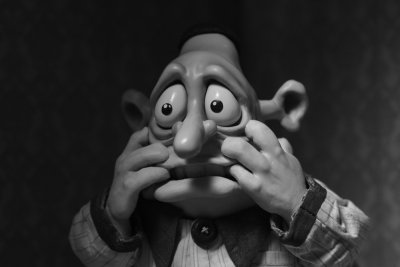Reviews - Mary & Max
Mary & Max
Reviewed By John Stakes

Mary & Max
Last Sunday’s double bill both from Australian director and animator Adam Elliot could not have been further removed from any of the offerings so far this season. Each featured inadequate and unfortunate men with deep psychological problems and had been dealt losing hands in the card game of life. At first glance not the most life affirming of themes you might think to tempt you into the cinema but life is full of surprises. Now nearing forty Eliot suffers from an hereditary disability in the form of a physiological tremor so it is perhaps not surprising that he should direct his artistic talents to highlight and foster understanding of those of us with afflictions.
First up it’s 1922 and “Harvie Krumpet”, a Polish man suffering from Tourette’s syndrome, is struck by lightning and loses part of his reproductive organs. However, Elliot’s Harvie is in fact a 2004 Oscar winning animated creation in clay who, despite a disaster ridden life, enjoys it to the full. He collects “fakts” in the manner taught by his illiterate mother who decided to educate him at home He tells us at the film’s conclusion that Fakt number 1034 is that life is like a cigarette-smoke it to the butt!
And for twenty two minutes of our time this is precisely what he did and quite an uplifting experience it turned out to be. Elliot’s second and longer film his 2009 “Mary and Max” is a blackly comic drama with its theme of the loneliness of eight years old Mary Daisy and forty four years old morbidly obese Max (voice-over Philip Seymour Hoffman making his presence felt yet again and sounding like the laconic Jewish American comedian Jackie Mason!). Neither film was ever likely to secure a general cinema release notwithstanding their animated “claymation” formats so it is only through the medium of our eagle-eyed and knowledgeable film club committee that either film could ever reach a wider public than the average film festival audience The decision to screen both these idiosyncratic, eccentric and original adult animation films was inspired. What little gems both are!
When the English think of “claymation” two words come to mind: Nick Park. And indeed the man from Preston has gained Oscar level appreciation for his development of a film format first produced in 1908. But whereas Park developed this type of stop motion animation to take advantage of its obvious comic potential, rarely has it been produced dramatically for adult audiences.
But what is “claymation”? It involves sculpturing objects usually from clay or plasticine round a wire frame and then moving them minutely for every film frame exposure. A normal film is exposed at the rate of twenty four frames per second. A claymation exposure rate is usually around twelve frames per second. A film of the length of “Mary and Max” (some eighty minutes) will involve at least sixty thousand “stops” which explains why clay is gradually being replaced by rubber silicone apparently.
It’s 1976 in Australia. The easy to follow plot of “Mary and Max” (narrated by Barry Humphries) involves Mary Daisy, a little girl teased at school over her birth mark and lacking any parental support from her distant shed retreating dad and alcoholic kleptomaniac mother. Her only friend is a legless agoraphobic war veteran Len whose mail she collects. The pathos drenched story is so loaded at this point that the danger of indulging us with over-sentimentality looms but is kept under control by the film’s humour, humanity, quirky feel, striking visuals and adult content. Perhaps being the son of an acrobatic clown and raised on a prawn farm in the outback helped Elliot to develop his taste for visual eccentricity!
In search of a pen pal Mary Daisy decides to write to Max in New York. Their one connection (apart from loneliness) turns out to be their love of an animated cartoon series “The Noblets”. A correspondence relationship is quickly established and maintained over the next twenty years despite being tested by Mary Daisy’s pre-pubescent and growing desire to know about the adult world. This triggers anxiety attacks from Max and leads to his becoming institutionalised. However he becomes more settled when diagnosed with Asperger’s syndrome and resumes his correspondence with Mary.
Mary grows up to become a psychologist and publishes a book about her relationship with Max which ruptures their friendship. Mary shreds her book and loses her career. Her personal life goes into a nose dive to the point where she decides on suicide in ignorance of her pregnancy. She is saved when agoraphobia free Len finds a reconciliation package from Max (containing his collection of Noblet figures) on her doorstep and the following year she travels to the US with her child to meet him. However she finds on arrival he has just died but Mary is fortified and overjoyed to discover he has papered his ceiling with a scrapbook of their letters.
It is the ability of the characters, loners all and lonely, not to let their disadvantages determine their lives and to rise above adversity which invests both films with life affirming appeal. Although at times both animations were infused with cutesy charm bordering on the sickly and occasional grotesque imagery, Elliot’s occasionally alarming visuals reflected how their conditions and the reactions of the world around must have felt to these unfortunates. The director’s manipulation of our senses and emotions never quite approached the shameless and his take on their world was highly individual. Once again a film to divide opinion but for this reviewer Elliot’s work was intelligent, imaginative, genre-twistingly different, engrossing, and, if nothing else, not likely to be easily forgotten.
Elliot has acquired a niche status in stop motion animation and is currently working on a new film yet to be titled but scheduled for completion in 2012.
First up it’s 1922 and “Harvie Krumpet”, a Polish man suffering from Tourette’s syndrome, is struck by lightning and loses part of his reproductive organs. However, Elliot’s Harvie is in fact a 2004 Oscar winning animated creation in clay who, despite a disaster ridden life, enjoys it to the full. He collects “fakts” in the manner taught by his illiterate mother who decided to educate him at home He tells us at the film’s conclusion that Fakt number 1034 is that life is like a cigarette-smoke it to the butt!
And for twenty two minutes of our time this is precisely what he did and quite an uplifting experience it turned out to be. Elliot’s second and longer film his 2009 “Mary and Max” is a blackly comic drama with its theme of the loneliness of eight years old Mary Daisy and forty four years old morbidly obese Max (voice-over Philip Seymour Hoffman making his presence felt yet again and sounding like the laconic Jewish American comedian Jackie Mason!). Neither film was ever likely to secure a general cinema release notwithstanding their animated “claymation” formats so it is only through the medium of our eagle-eyed and knowledgeable film club committee that either film could ever reach a wider public than the average film festival audience The decision to screen both these idiosyncratic, eccentric and original adult animation films was inspired. What little gems both are!
When the English think of “claymation” two words come to mind: Nick Park. And indeed the man from Preston has gained Oscar level appreciation for his development of a film format first produced in 1908. But whereas Park developed this type of stop motion animation to take advantage of its obvious comic potential, rarely has it been produced dramatically for adult audiences.
But what is “claymation”? It involves sculpturing objects usually from clay or plasticine round a wire frame and then moving them minutely for every film frame exposure. A normal film is exposed at the rate of twenty four frames per second. A claymation exposure rate is usually around twelve frames per second. A film of the length of “Mary and Max” (some eighty minutes) will involve at least sixty thousand “stops” which explains why clay is gradually being replaced by rubber silicone apparently.
It’s 1976 in Australia. The easy to follow plot of “Mary and Max” (narrated by Barry Humphries) involves Mary Daisy, a little girl teased at school over her birth mark and lacking any parental support from her distant shed retreating dad and alcoholic kleptomaniac mother. Her only friend is a legless agoraphobic war veteran Len whose mail she collects. The pathos drenched story is so loaded at this point that the danger of indulging us with over-sentimentality looms but is kept under control by the film’s humour, humanity, quirky feel, striking visuals and adult content. Perhaps being the son of an acrobatic clown and raised on a prawn farm in the outback helped Elliot to develop his taste for visual eccentricity!
In search of a pen pal Mary Daisy decides to write to Max in New York. Their one connection (apart from loneliness) turns out to be their love of an animated cartoon series “The Noblets”. A correspondence relationship is quickly established and maintained over the next twenty years despite being tested by Mary Daisy’s pre-pubescent and growing desire to know about the adult world. This triggers anxiety attacks from Max and leads to his becoming institutionalised. However he becomes more settled when diagnosed with Asperger’s syndrome and resumes his correspondence with Mary.
Mary grows up to become a psychologist and publishes a book about her relationship with Max which ruptures their friendship. Mary shreds her book and loses her career. Her personal life goes into a nose dive to the point where she decides on suicide in ignorance of her pregnancy. She is saved when agoraphobia free Len finds a reconciliation package from Max (containing his collection of Noblet figures) on her doorstep and the following year she travels to the US with her child to meet him. However she finds on arrival he has just died but Mary is fortified and overjoyed to discover he has papered his ceiling with a scrapbook of their letters.
It is the ability of the characters, loners all and lonely, not to let their disadvantages determine their lives and to rise above adversity which invests both films with life affirming appeal. Although at times both animations were infused with cutesy charm bordering on the sickly and occasional grotesque imagery, Elliot’s occasionally alarming visuals reflected how their conditions and the reactions of the world around must have felt to these unfortunates. The director’s manipulation of our senses and emotions never quite approached the shameless and his take on their world was highly individual. Once again a film to divide opinion but for this reviewer Elliot’s work was intelligent, imaginative, genre-twistingly different, engrossing, and, if nothing else, not likely to be easily forgotten.
Elliot has acquired a niche status in stop motion animation and is currently working on a new film yet to be titled but scheduled for completion in 2012.
Find A Film
Search over 1450 films in the Keswick Film Club archive.
Friends
KFC is friends with Caldbeck Area Film Society and Brampton Film Club and members share benefits across all organisations
Awards
Keswick Film Club won the Best New Film Society at the British Federation Of Film Societies awards in 2000.
Since then, the club has won Film Society Of The Year and awards for Best Programme four times and Best Website twice.
We have also received numerous Distinctions and Commendations in categories including marketing, programming and website.
 Talking Pictures
The KFC Newsletter
Talking Pictures
The KFC Newsletter
Links Explore the internet with Keswick Film Club


